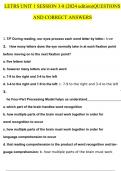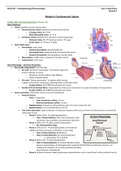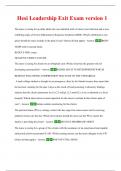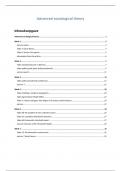Period Semester 2 of 2017-2018
Lecturer A. Lemmens (and Ilona Weeterings)
Summary made by Mirte van Schaijk
Including • All sessions and tutorials and extra
examples from my assignment.
Excluding
Version 2
,SUMMARY CONJOINT ANALYSIS 2017-2018 SEND TO: STUVIA
Index
Session 1 Introduction Week 1 .............................................................................................. 4
1 Introduction................................................................................................................................ 4
1.1 Course objective ..................................................................................................................... 4
1.2 What can you do with this course? ........................................................................................ 4
1.3 Why do we need a course for this? ........................................................................................ 5
1.4 Conjoint versus Direct survey (from session 2)....................................................................... 5
1.5 Conjoint analysis ..................................................................................................................... 5
1.6 Course overview ........................................................................................................................... 6
2 Conjoint analysis......................................................................................................................... 6
2.1 From Ranking-based to rating-based to choice-based ........................................................... 7
2.2 Example of choice-based ........................................................................................................ 9
2.3 Outcomes of a Conjoint analyses ........................................................................................... 9
2.4 Three level of analysis .......................................................................................................... 10
2.5 What can the choice sumlator do? ....................................................................................... 11
2.6 Why conjoint analysis ........................................................................................................... 11
2.7 Disadvantages of Conjoint Analysis ...................................................................................... 11
Session 2 Conjoint Design part 1 Week 1 .............................................................................. 12
1 Random Utility Theory.............................................................................................................. 12
2 Steps of Conjoint analysis ......................................................................................................... 14
Step 1 Determine the type of study ............................................................................................ 14
Step 2 Identify the relevant attributes........................................................................................ 14
Step 3 Specify attributes’ levels .................................................................................................. 15
Session 3 Conjoint Design part 2 Week 2 .............................................................................. 16
Step 4 Design questionnaire ....................................................................................................... 16
Step 5 Collecting the data ........................................................................................................... 23
Tutorial 1 Conjoint Design Week 2 ........................................................................................ 23
Session 4 Conjoint Analysis: Counting 1/2 Week 4 .................................................................. 24
1 Counting analysis ...................................................................................................................... 26
Tutorial 2 Counting Analysis Week 6 ..................................................................................... 27
Step 6 Estimating Part-worths .................................................................................................... 27
1.3 Joint effects .......................................................................................................................... 29
Session 4 Conjoint Analysis: Logit 2/2 Week 4 ....................................................................... 31
2 Logistic Regression ................................................................................................................... 31
Tutorial 2 Logistic Regression Week 6 .................................................................................... 33
Step 6 Estimating Part-worths .................................................................................................... 33
Page 2 of 92
MADE BY : M IRTE VAN SCHAIJK
,SUMMARY CONJOINT ANALYSIS 2017-2018 SEND TO: STUVIA
2.1 Summary of model fit ........................................................................................................... 33
2.2 part-worth estimates & t-stats ............................................................................................. 35
2.3 Attribute importance ............................................................................................................ 38
Zero-centered Diffs .......................................................................................................................... 39
Session 5 Conjoint Analysis: LCA Week 5 .............................................................................. 40
3 Latent Class Analysis ................................................................................................................. 40
Tutorial 2 Latent Class Model Week 6 ................................................................................... 49
Step 6 Estimating Part-worths .................................................................................................... 49
3.1 Number of segment.............................................................................................................. 49
3.2 Segment sizes | prior Probabilities ....................................................................................... 50
3.3 Utility (Part-worth) per segment .......................................................................................... 51
3.4 Utility (part-worth) across segment...................................................................................... 52
3.5 Importance of attribute ........................................................................................................ 53
3.6 Profiling variables ................................................................................................................. 53
Session 6 Conjoint Analysis: HB Week 6................................................................................ 56
4 Hierarchical Bayes .................................................................................................................... 56
Tutorial 3 Hierarchical Bayes Week 6 ..................................................................................... 59
Step 6 Estimating Part-worths .................................................................................................... 59
4.1 Iterative process .................................................................................................................. 59
4.1 Sample (average) Utilities .................................................................................................... 60
3.3 Posterior distribution ........................................................................................................... 61
3.4 Attribute importance ............................................................................................................ 62
3.5 Individual importance ........................................................................................................... 63
3.6 Profiling ................................................................................................................................ 64
Session 7 Choice simulator Week 7 ...................................................................................... 66
Tutorial 4 Simulation Week 7 ............................................................................................... 72
Step 7 Design market simulators ................................................................................................ 72
Scenario 0 Base Case Scenario.................................................................................................. 74
Scenario 1 New product introduction ...................................................................................... 76
Scenario 2 Product amelioration .............................................................................................. 79
Scenario 3 Sensitivity analysis .................................................................................................. 81
Scenario 4 Product portfolio / line optimization ...................................................................... 84
Session 8 Q&A Week 7 ..................................................................................................... 87
Page 3 of 92
MADE BY : M IRTE VAN SCHAIJK
, SUMMARY CONJOINT ANALYSIS 2017-2018 SEND TO: STUVIA
Session 1 Introduction Week 1
rd
Date 23 of October 2017
1 Introduction
1.1 Course objective
There are a lot of new products in the market. You can’t only survive with your old products, you
need to bed on new products.
Every year, many new products are introduced But very few succeed
This is a major issue for companies. Companies spend a lot of money to the research and
development of new products. But: it isn’t about how much they spend, but how you spend it.
Example Sony waterproof phone
Sony introduced a waterproof phone, but wasn’t a successful strategy. Because they didn’t know
how important a waterproof (= attribute) is for a consumer. It isn’t about how much they spend,
but how you spend it.
Companies don’t know which product launch will be a success. We want to predict that with Conjoint
Analysis. At the end of this course, you will be able to help companies design products that work.
1.2 What can you do with this course?
(see scenarios of session 7)
Before they did this with a survey, is price important? How important? How
much to spend? But everyone wants the best quality for the lowest price.
That’s the problem with a direct survey. With conjoint you get the actual trade-
off consumers make.
How much is this product gonna cannibalize your own product
Page 4 of 92
MADE BY : M IRTE VAN SCHAIJK










